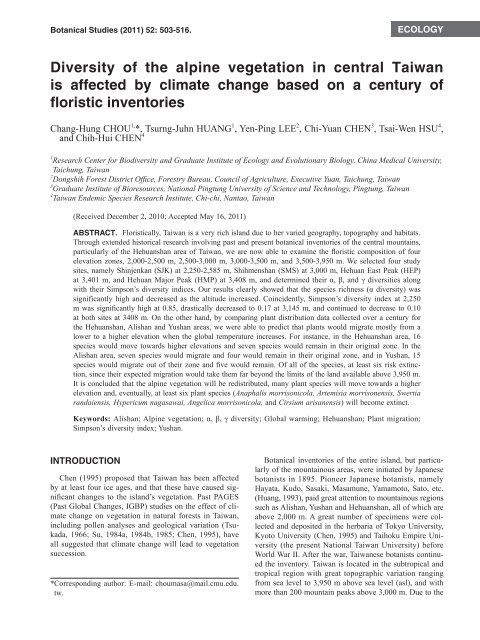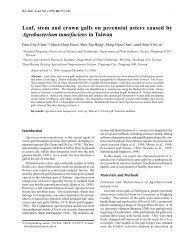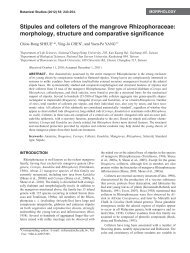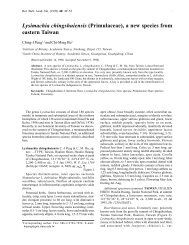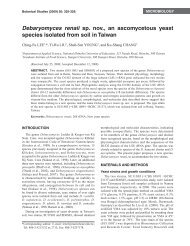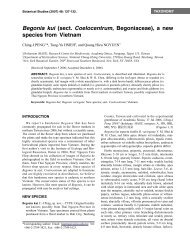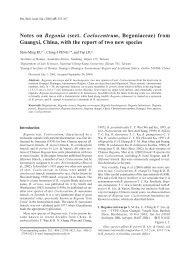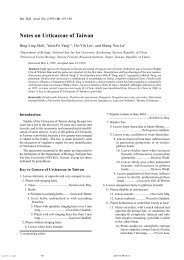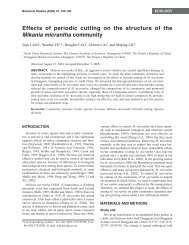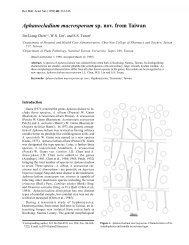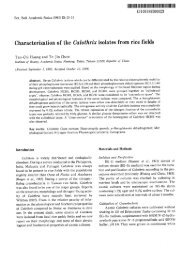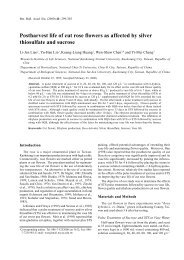Diversity of the alpine vegetation in central ... - Academia Sinica
Diversity of the alpine vegetation in central ... - Academia Sinica
Diversity of the alpine vegetation in central ... - Academia Sinica
You also want an ePaper? Increase the reach of your titles
YUMPU automatically turns print PDFs into web optimized ePapers that Google loves.
Botanical Studies (2011) 52: 503-516.<br />
<strong>Diversity</strong> <strong>of</strong> <strong>the</strong> <strong>alp<strong>in</strong>e</strong> <strong>vegetation</strong> <strong>in</strong> <strong>central</strong> Taiwan<br />
is affected by climate change based on a century <strong>of</strong><br />
floristic <strong>in</strong>ventories<br />
Chang-Hung CHOU 1, *, Tsurng-Juhn HUANG 1 , Yen-P<strong>in</strong>g LEE 2 , Chi-Yuan CHEN 3 , Tsai-Wen HSU 4 ,<br />
and Chih-Hui CHEN 4<br />
1<br />
Research Center for Biodiversity and Graduate Institute <strong>of</strong> Ecology and Evolutionary Biology, Ch<strong>in</strong>a Medical University,<br />
Taichung, Taiwan<br />
2<br />
Dongshih Forest District Office, Forestry Bureau, Council <strong>of</strong> Agriculture, Executive Yuan, Taichung, Taiwan<br />
3<br />
Graduate Institute <strong>of</strong> Bioresources, National P<strong>in</strong>gtung University <strong>of</strong> Science and Technology, P<strong>in</strong>gtung, Taiwan<br />
4<br />
Taiwan Endemic Species Research Institute, Chi-chi, Nantao, Taiwan<br />
(Received December 2, 2010; Accepted May 16, 2011)<br />
ABSTRACT. Floristically, Taiwan is a very rich island due to her varied geography, topography and habitats.<br />
Through extended historical research <strong>in</strong>volv<strong>in</strong>g past and present botanical <strong>in</strong>ventories <strong>of</strong> <strong>the</strong> <strong>central</strong> mounta<strong>in</strong>s,<br />
particularly <strong>of</strong> <strong>the</strong> Hehuanshan area <strong>of</strong> Taiwan, we are now able to exam<strong>in</strong>e <strong>the</strong> floristic composition <strong>of</strong> four<br />
elevation zones, 2,000-2,500 m, 2,500-3,000 m, 3,000-3,500 m, and 3,500-3,950 m. We selected four study<br />
sites, namely Sh<strong>in</strong>jenkan (SJK) at 2,250-2,585 m, Shihmenshan (SMS) at 3,000 m, Hehuan East Peak (HEP)<br />
at 3,401 m, and Hehuan Major Peak (HMP) at 3,408 m, and determ<strong>in</strong>ed <strong>the</strong>ir α, β, and γ diversities along<br />
with <strong>the</strong>ir Simpson’s diversity <strong>in</strong>dices. Our results clearly showed that <strong>the</strong> species richness (α diversity) was<br />
significantly high and decreased as <strong>the</strong> altitude <strong>in</strong>creased. Co<strong>in</strong>cidently, Simpson’s diversity <strong>in</strong>dex at 2,250<br />
m was significantly high at 0.85, drastically decreased to 0.17 at 3,145 m, and cont<strong>in</strong>ued to decrease to 0.10<br />
at both sites at 3408 m. On <strong>the</strong> o<strong>the</strong>r hand, by compar<strong>in</strong>g plant distribution data collected over a century for<br />
<strong>the</strong> Hehuanshan, Alishan and Yushan areas, we were able to predict that plants would migrate mostly from a<br />
lower to a higher elevation when <strong>the</strong> global temperature <strong>in</strong>creases. For <strong>in</strong>stance, <strong>in</strong> <strong>the</strong> Hehuanshan area, 16<br />
species would move towards higher elevations and seven species would rema<strong>in</strong> <strong>in</strong> <strong>the</strong>ir orig<strong>in</strong>al zone. In <strong>the</strong><br />
Alishan area, seven species would migrate and four would rema<strong>in</strong> <strong>in</strong> <strong>the</strong>ir orig<strong>in</strong>al zone, and <strong>in</strong> Yushan, 15<br />
species would migrate out <strong>of</strong> <strong>the</strong>ir zone and five would rema<strong>in</strong>. Of all <strong>of</strong> <strong>the</strong> species, at least six risk ext<strong>in</strong>ction,<br />
s<strong>in</strong>ce <strong>the</strong>ir expected migration would take <strong>the</strong>m far beyond <strong>the</strong> limits <strong>of</strong> <strong>the</strong> land available above 3,950 m.<br />
It is concluded that <strong>the</strong> <strong>alp<strong>in</strong>e</strong> <strong>vegetation</strong> will be redistributed, many plant species will move towards a higher<br />
elevation and, eventually, at least six plant species (Anaphalis morrisonicola, Artemisia morrisonensis, Swertia<br />
randaiensis, Hypericum nagasawai, Angelica morrisonicola, and Cirsium arisanensis) will become ext<strong>in</strong>ct.<br />
Keywords: Alishan; Alp<strong>in</strong>e <strong>vegetation</strong>; α, β, γ diversity; Global warm<strong>in</strong>g; Hehuanshan; Plant migration;<br />
Simpson’s diversity <strong>in</strong>dex; Yushan.<br />
INTRODUCTION<br />
Chen (1995) proposed that Taiwan has been affected<br />
by at least four ice ages, and that <strong>the</strong>se have caused significant<br />
changes to <strong>the</strong> island’s <strong>vegetation</strong>. Past PAGES<br />
(Past Global Changes, IGBP) studies on <strong>the</strong> effect <strong>of</strong> climate<br />
change on <strong>vegetation</strong> <strong>in</strong> natural forests <strong>in</strong> Taiwan,<br />
<strong>in</strong>clud<strong>in</strong>g pollen analyses and geological variation (Tsukada,<br />
1966; Su, 1984a, 1984b, 1985; Chen, 1995), have<br />
all suggested that climate change will lead to <strong>vegetation</strong><br />
succession.<br />
* Correspond<strong>in</strong>g author: E-mail: choumasa@mail.cmu.edu.<br />
tw.<br />
eCOlOgy<br />
Botanical <strong>in</strong>ventories <strong>of</strong> <strong>the</strong> entire island, but particularly<br />
<strong>of</strong> <strong>the</strong> mounta<strong>in</strong>ous areas, were <strong>in</strong>itiated by Japanese<br />
botanists <strong>in</strong> 1895. Pioneer Japanese botanists, namely<br />
Hayata, Kudo, Sasaki, Masamune, Yamamoto, Sato, etc.<br />
(Huang, 1993), paid great attention to mounta<strong>in</strong>ous regions<br />
such as Alishan, Yushan and Hehuanshan, all <strong>of</strong> which are<br />
above 2,000 m. A great number <strong>of</strong> specimens were collected<br />
and deposited <strong>in</strong> <strong>the</strong> herbaria <strong>of</strong> Tokyo University,<br />
Kyoto University (Chen, 1995) and Taihoku Empire University<br />
(<strong>the</strong> present National Taiwan University) before<br />
World War II. After <strong>the</strong> war, Taiwanese botanists cont<strong>in</strong>ued<br />
<strong>the</strong> <strong>in</strong>ventory. Taiwan is located <strong>in</strong> <strong>the</strong> subtropical and<br />
tropical region with great topographic variation rang<strong>in</strong>g<br />
from sea level to 3,950 m above sea level (asl), and with<br />
more than 200 mounta<strong>in</strong> peaks above 3,000 m. Due to <strong>the</strong>
504 Botanical Studies, Vol. 52, 2011<br />
variable climate and habitats, Taiwan possesses great plant<br />
diversity. Of <strong>the</strong> more than 4000 vascular plant species<br />
registered, more than 25% are endemic. The large amount<br />
<strong>of</strong> data accumulated over <strong>the</strong> past 100 years concern<strong>in</strong>g<br />
<strong>the</strong> flora and climatic conditions <strong>in</strong> Taiwan now make <strong>the</strong><br />
study <strong>of</strong> floristic changes related to climatic conditions<br />
possible.<br />
We used <strong>the</strong> follow<strong>in</strong>g <strong>in</strong>dices <strong>of</strong> diversity to understand<br />
changes <strong>in</strong> plant communities: α (alpha) diversity, β (beta)<br />
diversity and γ (gamma) diversity. Alpha diversity refers to<br />
<strong>the</strong> number <strong>of</strong> species <strong>in</strong> a certa<strong>in</strong> community; beta diversity<br />
represents <strong>the</strong> variability <strong>of</strong> species composition along<br />
an environmental or geographical gradient; and gamma<br />
diversity applies to larger geographical scales, referr<strong>in</strong>g to<br />
<strong>the</strong> number <strong>of</strong> species <strong>in</strong> a large region (Primack, 1998).<br />
These concepts are useful when study<strong>in</strong>g biological diversity<br />
<strong>in</strong> relation to conservation biology <strong>in</strong> a community or<br />
region, such as <strong>in</strong> natural reserves or national parks. Comb<strong>in</strong><strong>in</strong>g<br />
botanical <strong>in</strong>ventories and climatic <strong>in</strong>formation, we<br />
can use diversity <strong>in</strong>dices to understand <strong>vegetation</strong> change<br />
relative to climatic or topographic changes.<br />
Several recent <strong>in</strong>ternational conferences on biodiversity<br />
<strong>in</strong>formatics and <strong>the</strong> impact <strong>of</strong> climate change on life have<br />
taken place <strong>in</strong> different parts <strong>of</strong> <strong>the</strong> world (Dan BIF conference,<br />
2008; ISGMB, 2008; ISGBHHW, 2009). Many<br />
important questions were asked concern<strong>in</strong>g <strong>the</strong> extent to<br />
which global warm<strong>in</strong>g will affect Earth’s biodiversity,<br />
<strong>in</strong>clud<strong>in</strong>g <strong>the</strong> natural systems that susta<strong>in</strong> human societies.<br />
It is very difficult to apply traditional experimental<br />
approaches to <strong>in</strong>vestigate <strong>the</strong> large-scale and long-term nature<br />
<strong>of</strong> <strong>the</strong> issues without <strong>in</strong>volv<strong>in</strong>g biodiversity data and<br />
employ<strong>in</strong>g statistical analysis. Data from <strong>the</strong> Global Biodiversity<br />
Information Facility, GBIF, have made it possible<br />
to assess <strong>the</strong> change <strong>in</strong> biodiversity as affected by climate<br />
change. It is beyond doubt that <strong>the</strong> substantial floristic<br />
documents cover<strong>in</strong>g a century <strong>of</strong> exploration from several<br />
data banks <strong>in</strong> Taiwan and Japan, as well as <strong>the</strong> climatic<br />
data from <strong>the</strong> Central Wea<strong>the</strong>r Bureau <strong>of</strong> Taiwan, which<br />
has been registered s<strong>in</strong>ce <strong>the</strong> 1900s, allow us to <strong>in</strong>vestigate<br />
<strong>the</strong> aforementioned questions. In addition, <strong>the</strong> senior author<br />
<strong>in</strong>itiated a national <strong>the</strong>matic research program to address<br />
<strong>the</strong>se issues <strong>in</strong> 2006 (2006-2009).<br />
In fact, <strong>the</strong>re has been an <strong>in</strong>creas<strong>in</strong>g awareness and evidence<br />
<strong>of</strong> global warm<strong>in</strong>g over <strong>the</strong> last century (Prabhakar<br />
and Shaw, 2008; CCSC, 2009), which is lead<strong>in</strong>g to climate<br />
change and temperature <strong>in</strong>creases <strong>in</strong> <strong>the</strong> range <strong>of</strong> 0.6-1.5°C<br />
<strong>in</strong> many parts <strong>of</strong> <strong>the</strong> world. Negative impacts <strong>of</strong> climate<br />
change on ecosystems have also been demonstrated <strong>in</strong><br />
Taiwan (Chou, 2009). The Intergovernmental Panel on<br />
Climate Change (IPCC) has proposed different scenarios<br />
(A1, A2, B2, etc.) that predict <strong>the</strong> future change <strong>in</strong> global<br />
temperature. In Taiwan, we have observed and analyzed<br />
climatic changes s<strong>in</strong>ce <strong>the</strong> 1900s us<strong>in</strong>g data obta<strong>in</strong>ed from<br />
<strong>the</strong> Central Wea<strong>the</strong>r Bureau <strong>of</strong> Taiwan. If global warm<strong>in</strong>g<br />
occurs <strong>in</strong> Taiwan, it is hypo<strong>the</strong>sized that some plant<br />
species might migrate to higher elevations. Pearson and<br />
Raxworthy (2008) presented a case study on <strong>the</strong> extreme<br />
vulnerability <strong>of</strong> tropical mounta<strong>in</strong> endemic species due to<br />
climatic change, and concluded that endemic species <strong>in</strong><br />
Madagascar distributed close to summits may be especially<br />
vulnerable to ext<strong>in</strong>ction due to <strong>the</strong>ir upward movement.<br />
Few studies have addressed how climate change, and <strong>in</strong><br />
particular changes <strong>in</strong> temperature and precipitation, affect<br />
<strong>the</strong> diversity <strong>of</strong> <strong>vegetation</strong> <strong>in</strong> mounta<strong>in</strong> areas (Beerl<strong>in</strong>g and<br />
Woodward, 1994). We <strong>the</strong>refore attempt here<strong>in</strong> to assess<br />
<strong>the</strong> correlation between climate change and plant diversity<br />
<strong>in</strong> Taiwan based on one century <strong>of</strong> wea<strong>the</strong>r data and<br />
botanical records. However, it is ra<strong>the</strong>r difficult to address<br />
<strong>the</strong> subject <strong>in</strong> <strong>the</strong> lower elevations <strong>in</strong> Taiwan due to <strong>the</strong><br />
many socio-economic factors affect<strong>in</strong>g <strong>the</strong> natural <strong>vegetation</strong>.<br />
Therefore, our analyses concentrate on remote areas,<br />
particularly <strong>in</strong> <strong>the</strong> <strong>central</strong> mounta<strong>in</strong>s above a 2,000-m elevation,<br />
such as Alishan, Hehuanshan and Yushan, with a<br />
special emphasis on <strong>the</strong> Hehuanshan region.<br />
MATeRIAlS AND MeTHODS<br />
Study sites<br />
Taiwan is located to <strong>the</strong> sou<strong>the</strong>ast <strong>of</strong> Ch<strong>in</strong>a (21°53’50’’-<br />
25°18’20’’ N; 120°01’00’’-121°59’15’’ E), and with <strong>the</strong><br />
tropic <strong>of</strong> Cancer pass<strong>in</strong>g through Chia-Yi <strong>in</strong> sou<strong>the</strong>rn Taiwan;<br />
it is both subtropical and tropical. The topography <strong>of</strong><br />
Taiwan ranges from sea level to 3,950 m above sea level,<br />
and has more than 200 peaks reach<strong>in</strong>g above 3,000 m.<br />
The average temperature is 28°C <strong>in</strong> summer and 14°C <strong>in</strong><br />
w<strong>in</strong>ter. The average annual precipitation is 2,515 mm, but<br />
<strong>the</strong> ra<strong>in</strong> is <strong>of</strong>ten concentrated <strong>in</strong> <strong>the</strong> few months from July<br />
to September. A dry period from November to April is particularly<br />
pronounced <strong>in</strong> sou<strong>the</strong>rn Taiwan.<br />
It is impossible to survey <strong>the</strong> floristic diversity <strong>of</strong> <strong>the</strong><br />
entire <strong>alp<strong>in</strong>e</strong> region; thus, we selected <strong>the</strong> Hehuanshan<br />
area (Nantou County) for detailed study. Four sites were<br />
selected along highway 14A at elevations <strong>of</strong> 2,550-3,500<br />
m above sea level:<br />
1. Sh<strong>in</strong>jenkan (SJK) is located at 21.5 K ~ 22 K, Highway<br />
14A, situated at 121°12’52.8” East and 24°06’46.5”<br />
North. The sampl<strong>in</strong>g site for shrubs is located at<br />
2,585 m asl (above sea level) at 121°12’53” East and<br />
24°06’49.3” North.<br />
2. Shihmenshan (SMS) is located at 34 K, Highway 14A,<br />
at 3,145 m asl, 121°17’03.5” East and 24°08’48.1”<br />
North.<br />
3. Hehuan East Peak (HEP) is located at 3,401 m asl,<br />
121°16’54.0” East, 24°08’11.3” North.<br />
4. Hehuan Major Peak (HMP) is located at 3,408 m asl,<br />
121°16’17.7” East, 24°08’30.6” North.<br />
Botanical <strong>in</strong>ventory <strong>of</strong> <strong>alp<strong>in</strong>e</strong> <strong>vegetation</strong> from<br />
data banks <strong>in</strong> Taiwan<br />
Several botanical databases are available from <strong>the</strong><br />
Biodiversity Research Center <strong>of</strong> <strong>Academia</strong> S<strong>in</strong>ica, Taipei<br />
(BRC/AS) (http://dbIn.S<strong>in</strong>ica.edu.tw/textdb/hast_<br />
labelquery.php), National Taiwan University (http://tai2.
CHOU et al. —<strong>Diversity</strong> <strong>of</strong> <strong>alp<strong>in</strong>e</strong> <strong>vegetation</strong> affected by climate change 505<br />
ntu.tw/webtaiprog/web.query-aspx), and Taiwan Forestry<br />
Research Institute (http://taif.tfri.gov.tw:8080/spec-query.<br />
aspx). We surveyed plant species distributed <strong>in</strong> <strong>the</strong> Hehuanshan<br />
area, arbitrarily divided <strong>in</strong>to 4 elevation zones<br />
(2,000-2,500 m, 2,500-3,000 m, 3,000-3,500 m, and above<br />
3,500 m) and listed <strong>the</strong> plant species, genera, and families<br />
found with<strong>in</strong> each zone. The plant species nomenclature<br />
follows Flora <strong>of</strong> Taiwan (2nd edition, Huang et al., 2002);<br />
<strong>in</strong> addition, a list <strong>of</strong> rare and endangered species was obta<strong>in</strong>ed<br />
from <strong>the</strong> database <strong>of</strong> <strong>the</strong> Council <strong>of</strong> Agriculture,<br />
Taiwan (Chou et al., 2009, unpublished report).<br />
<strong>Diversity</strong> measurement<br />
We determ<strong>in</strong>ed <strong>the</strong> α, β, and γ diversity <strong>of</strong> <strong>vegetation</strong><br />
and used Simpson’s diversity <strong>in</strong>dex to make a comparison<br />
between sampl<strong>in</strong>g sites and time. The equation <strong>of</strong> Simpson’s<br />
diversity <strong>in</strong>dex was described by Simpson (1949).<br />
At <strong>the</strong> study sites, plants were sampled based on <strong>the</strong><br />
botanical survey <strong>of</strong> quadrates (10 × 10 m each) and on<br />
and transect sampl<strong>in</strong>g (20 m long) at an <strong>in</strong>terval <strong>of</strong> 100 m<br />
along Highway 14A from an elevation <strong>of</strong> 2,250 to 2,750 m.<br />
exam<strong>in</strong>ation <strong>of</strong> plant specimens <strong>in</strong> herbaria <strong>in</strong><br />
Japan and Taiwan<br />
From <strong>the</strong> databases mentioned above, we downloaded<br />
relevant <strong>in</strong>formation for each species found at our selected<br />
study sites. We consulted <strong>the</strong> herbarium <strong>of</strong> Tokyo University<br />
to add any <strong>in</strong>formation from early documents and recent<br />
f<strong>in</strong>d<strong>in</strong>gs that had not been uploaded to <strong>the</strong> databases. For<br />
<strong>the</strong> 367 plant species that were recorded <strong>in</strong> <strong>the</strong> Hehuanshan<br />
area, we carefully checked all vouchers deposited <strong>in</strong> <strong>the</strong><br />
herbaria and <strong>the</strong> contents <strong>of</strong> several databases <strong>in</strong> Taiwan.<br />
We obta<strong>in</strong>ed a list <strong>of</strong> species found at <strong>the</strong> Sh<strong>in</strong>jenkan site<br />
<strong>in</strong> different years and at different elevations (Chou et al.<br />
2009, unpublished report, or see Supplementary Table 1).<br />
Check<strong>in</strong>g climatic data from <strong>the</strong> last century <strong>in</strong><br />
Taiwan<br />
S<strong>in</strong>ce 1895, wea<strong>the</strong>r stations have been established <strong>in</strong><br />
most areas <strong>in</strong> Taiwan. Wea<strong>the</strong>r data from <strong>the</strong> last century<br />
were obta<strong>in</strong>ed from <strong>the</strong> Central Wea<strong>the</strong>r Bureau <strong>of</strong> Taiwan;<br />
however, <strong>the</strong> data from <strong>the</strong> Hehuanshan are <strong>in</strong>complete<br />
due to <strong>the</strong> lack <strong>of</strong> a wea<strong>the</strong>r station <strong>the</strong>re at <strong>the</strong> beg<strong>in</strong>n<strong>in</strong>g<br />
<strong>of</strong> <strong>the</strong> 20th century. Instead, we obta<strong>in</strong>ed data from nearby<br />
stations at Alishan and Yushan, which are relatively close<br />
to <strong>the</strong> Hehuanshan site. The average annual temperature<br />
and precipitation s<strong>in</strong>ce 1930 are presented <strong>in</strong> Figure 1.<br />
Statistical analysis<br />
All species are listed <strong>in</strong> an Office Excel 2007 table accord<strong>in</strong>g<br />
to altitude, and <strong>the</strong> elevations <strong>of</strong> each species’ distribution<br />
vs. year <strong>of</strong> each species’ record<strong>in</strong>g were analyzed<br />
statistically us<strong>in</strong>g standard deviation (SD) as described by<br />
Gomez and Gomez (1976). An adjusted SD was obta<strong>in</strong>ed<br />
accord<strong>in</strong>g to <strong>the</strong> formula which was used by Jump et al.<br />
(2006):<br />
Adjusted SD =<br />
Each Elevation - Mean Elevation <strong>of</strong> Each Species<br />
SD Elevation<br />
The expected elevation <strong>of</strong> migrated species was represented<br />
by M (mean elevation <strong>in</strong> meter) plus SD (standard<br />
deviation). For example, Acer serrulatum was documented<br />
at <strong>the</strong> first time <strong>in</strong> 1984 at 2,200 m asl and was later documented<br />
<strong>in</strong> 1999 at 2,400 m asl. From <strong>the</strong> two data, we<br />
obta<strong>in</strong>ed a mean elevation <strong>of</strong> 2,300 m and a standard deviation<br />
(SD) <strong>of</strong> 141.42 m. From <strong>the</strong> mean and SD, it was<br />
deduced that <strong>the</strong> plant might move upwards to an expected<br />
elevation <strong>of</strong> 2,441 m. Follow<strong>in</strong>g this comput<strong>in</strong>g process,<br />
we were able to assess <strong>the</strong> migration <strong>of</strong> each plant to a certa<strong>in</strong><br />
altitude.<br />
estimation <strong>of</strong> available land area <strong>in</strong> <strong>the</strong> Hehuanshan<br />
area<br />
Us<strong>in</strong>g ArcView s<strong>of</strong>tware and a digital geographic<br />
model (Digital Terra<strong>in</strong> Model, DTM), and through communication<br />
with Pr<strong>of</strong>. Chen at <strong>the</strong> National P<strong>in</strong>gtung University<br />
<strong>of</strong> Science and Technology, Taiwan, <strong>the</strong> land area<br />
<strong>of</strong> Hehuanshan above 2,000 m was estimated by divid<strong>in</strong>g<br />
<strong>in</strong>to five elevational zones (2,000-2,250 m, 2,250-2,500 m,<br />
2,500-2,750 m, 2,750-3,000 m, and above 3,000 m). The<br />
estimated available land area is expressed as a percentage<br />
(Chou et al., 2009, unpublished report).<br />
ReSUlT AND DISCUSSION<br />
Botanical diversity <strong>in</strong> <strong>the</strong> <strong>alp<strong>in</strong>e</strong> area <strong>of</strong> Taiwan<br />
We attempted to study <strong>the</strong> botanical diversity <strong>of</strong> <strong>alp<strong>in</strong>e</strong><br />
plants based on a century <strong>of</strong> botanical <strong>in</strong>ventories documented<br />
<strong>in</strong> <strong>the</strong> databases <strong>of</strong> various Taiwanese <strong>in</strong>stitutions.<br />
Appropriately 25,000 specimens have been collected <strong>in</strong><br />
our study area above an elevation <strong>of</strong> 2,000 m, <strong>in</strong>clud<strong>in</strong>g<br />
132 families, 557 genera, and 1442 species (Table 1). In<br />
<strong>the</strong> elevation zone <strong>of</strong> 2,000-2,500 m, we recorded 1266<br />
species, 527 genera, and 131 families; <strong>in</strong> <strong>the</strong> 2,500-3,000<br />
zone we recorded 829 species; <strong>in</strong> <strong>the</strong> 3,000-3,500 m zone<br />
we recorded 561 species; and above 3,500 m we recorded<br />
252 species (Huang et al., 2002). It is clear that <strong>the</strong> number<br />
<strong>of</strong> plant species decreases with <strong>in</strong>creas<strong>in</strong>g elevation.<br />
At <strong>the</strong> same time, <strong>the</strong> available land decreases with altitude.<br />
For example, <strong>in</strong> <strong>the</strong> Hehuanshan area, <strong>the</strong> available<br />
land <strong>in</strong> elevation zone C (2,500-2,750 m) corresponds to<br />
94% <strong>of</strong> <strong>the</strong> land area <strong>in</strong> elevation zone D (2,750-3,000 m),<br />
and <strong>the</strong> area <strong>in</strong> zone E (3,000-3,421 m) is equal to 30% <strong>of</strong><br />
<strong>the</strong> area <strong>in</strong> elevation zone D (2,750-3,000 m) (Table 2).<br />
Logistically, under global warm<strong>in</strong>g <strong>in</strong> <strong>the</strong> region, plant<br />
species would migrate upwards to <strong>the</strong> higher elevations <strong>in</strong><br />
zone E, where <strong>the</strong> available land for plant growth is only<br />
30% <strong>of</strong> <strong>the</strong> area previously occupied (Table 2); <strong>in</strong> o<strong>the</strong>r<br />
words, about 70% <strong>of</strong> plant species might not survive due<br />
to limited space. However, most endemic species may not<br />
be seriously affected by global warm<strong>in</strong>g. In <strong>the</strong> Hehuanshan<br />
area, <strong>the</strong>re are 480 endemic species, about one-third<br />
<strong>of</strong> <strong>the</strong> total number <strong>of</strong> species found <strong>in</strong> <strong>the</strong> mounta<strong>in</strong>ous
506 Botanical Studies, Vol. 52, 2011<br />
Table 1. A summary <strong>of</strong> <strong>the</strong> number <strong>of</strong> plant families, genera, and species distributed <strong>in</strong> four elevation zones <strong>of</strong> <strong>the</strong> Central mounta<strong>in</strong><br />
area <strong>of</strong> Taiwan based on a century <strong>of</strong> botanical <strong>in</strong>ventories. Data are syn<strong>the</strong>sized from Flora <strong>of</strong> Taiwan (2002).<br />
Altitude (m) Pteridophytes Gymnosperms<br />
2000-2500<br />
2500-3000<br />
3000-3500<br />
3500-3950<br />
Total<br />
region. We concluded that some species, even though <strong>the</strong>y<br />
can migrate to higher elevations, may become ext<strong>in</strong>ct<br />
anyway due to <strong>the</strong> limited space and to <strong>the</strong> environmental<br />
stress <strong>in</strong> <strong>the</strong>se areas (Chen, 1995). In Taiwan, <strong>vegetation</strong><br />
is almost absent at elevations above 3,900 m, which is<br />
similar to that documented for <strong>the</strong> island <strong>of</strong> Madagascar<br />
(Pearson and Raxworthy, 2008).<br />
Botanical <strong>in</strong>ventory at <strong>the</strong> Sh<strong>in</strong>jenkan study site<br />
The Sh<strong>in</strong>jenkan study site, located at a 2,250-m elevation<br />
along Highway 14A, is a unique ecotone for <strong>alp<strong>in</strong>e</strong><br />
<strong>vegetation</strong>, featur<strong>in</strong>g <strong>alp<strong>in</strong>e</strong> herbaceous plants, shrubs, and<br />
woody plants. This transitional site lends itself to <strong>the</strong> study<br />
<strong>of</strong> <strong>vegetation</strong> composition and succession. The senior author<br />
has taken students and researchers to this site s<strong>in</strong>ce<br />
1984 and has made an extensive survey <strong>of</strong> its botanical<br />
composition from 1984-1990 and 2007-2009. A complete<br />
list <strong>of</strong> <strong>the</strong> species encountered is presented <strong>in</strong> Supplementary<br />
Table 1. In total, 88 species were found at <strong>the</strong><br />
Sh<strong>in</strong>jenkan site, all <strong>of</strong> which were found <strong>in</strong> o<strong>the</strong>r parts <strong>of</strong><br />
<strong>the</strong> Central Mounta<strong>in</strong> <strong>alp<strong>in</strong>e</strong> region. Thirty three <strong>of</strong> <strong>the</strong>se<br />
species were recorded over 100 years ago (1905-2010),<br />
25 species were recorded over 90 years ago (1911-2010),<br />
15 species over 80 years ago (1922-2010), two species recorded<br />
before 1940, and <strong>the</strong> rema<strong>in</strong><strong>in</strong>g species were documented<br />
after 1963 (Supplementary Table 1).<br />
Angiosperms<br />
Dicotyledons Monocotyledons<br />
Families 20 5 94 12 131<br />
Genera 61 13 352 101 527<br />
Species 159 17 879 211 1,266<br />
Families 19 3 76 9 107<br />
Genera 45 10 235 72 362<br />
Species 112 12 550 155 829<br />
Families 15 2 61 7 85<br />
Genera 28 4 169 55 256<br />
Species 76 6 367 112 561<br />
Families 5 2 41 6 54<br />
Genera 9 3 101 31 144<br />
Species 16 4 181 51 252<br />
Families 20 5 95 12 132<br />
Genera 67 14 366 110 557<br />
Species 200 19 965 258 1,442<br />
Total<br />
Table 2. Estimated available land <strong>in</strong> <strong>the</strong> five elevation zones <strong>in</strong><br />
<strong>the</strong> Hehuanshan area*.<br />
Elevation<br />
(m)<br />
Estimated area<br />
(ha)<br />
Expected available area,<br />
× 100%<br />
A 2000-2250 1330 100<br />
B 2250-2500 1380 103 (1380/1330)<br />
C 2500-2750 1593 115 (1593/1380)<br />
D 2750-3000 1500 94 (1500/1593)<br />
E 3000-3421 458 30 (458/1500)<br />
Total 6261<br />
*Available land for plant growth as plants migrate upwards.<br />
In addition, a comparison <strong>of</strong> <strong>the</strong> botanical compositions<br />
<strong>of</strong> pteridophytes, gymnosperms, and angiosperms<br />
(<strong>in</strong>clud<strong>in</strong>g dicotyledon and monocotyledon) reveals that<br />
<strong>the</strong>re were 62 species <strong>in</strong> 1984, 90 species <strong>in</strong> 2007, and 83<br />
species <strong>in</strong> 2008 (Table 3). The number <strong>of</strong> species appeared<br />
to <strong>in</strong>crease from 1984 to 2008, and naturally, we cannot<br />
discount <strong>the</strong> hypo<strong>the</strong>sis that this significant <strong>in</strong>crease is due<br />
to global warm<strong>in</strong>g.<br />
Botanical composition <strong>of</strong> <strong>the</strong> Hehuan east Peak<br />
At <strong>the</strong> Hehuan East Peak study site, we made an <strong>in</strong>-
CHOU et al. —<strong>Diversity</strong> <strong>of</strong> <strong>alp<strong>in</strong>e</strong> <strong>vegetation</strong> affected by climate change 507<br />
ventory <strong>of</strong> <strong>the</strong> seasonal species distribution for 2008 and<br />
2009. Twenty-four species (A<strong>in</strong>sliaea macrocl<strong>in</strong>idioides,<br />
Carex spp., C. satzumensis, Deschampsia flexuosa, Festuca<br />
ov<strong>in</strong>a, E. rubra, Gentiana arisanensis, G. davidii var.<br />
formosana, Hieracium morii, Hypericum nagasawae, Juniperus<br />
formosnus, J. squamata, Lycopodium lavatum, L.<br />
obscurum, L. pseudoclavatum, L. selago var. appressum,<br />
L. veitchii, Miscanthus transmorrisonensis, Platan<strong>the</strong>ra<br />
brevicalcarata, Rhododendron pseudochrysanthum, Solidago<br />
virgaurea var. leiocarpa, Trichophorum subcapitatum,<br />
Veratrum formosanum and Yushania niitakayamensis)<br />
were commonly found both years (Table 4). Of <strong>the</strong>se, five<br />
species (Gentiana arisanensis, L. obscurum, M. transmorrisonensis,<br />
Trichophorum subcapitatum and Yushania<br />
niitakayamensis) were present every season, <strong>in</strong>dicat<strong>in</strong>g<br />
<strong>the</strong>ir dom<strong>in</strong>ance. Some species may have died or were not<br />
found <strong>in</strong> <strong>the</strong> w<strong>in</strong>ter or spr<strong>in</strong>g. Thus, <strong>the</strong> α diversity at <strong>the</strong><br />
site is about 24, a ra<strong>the</strong>r low value for species diversity.<br />
Comparison <strong>of</strong> species diversity <strong>in</strong> <strong>the</strong> Hehuanshan<br />
area<br />
A botanical <strong>in</strong>ventory <strong>of</strong> <strong>the</strong> Hehuanshan area was<br />
performed at four study sites (Sh<strong>in</strong>jenkan, Shihmenshan,<br />
Hehuan East Peak, and Hehuan Major Peak). The total<br />
number <strong>of</strong> species and <strong>the</strong> α, β, γ diversity are presented <strong>in</strong><br />
Table 5. The alpha (α) diversity is related to <strong>the</strong> population<br />
concept <strong>of</strong> species richness and can be used to compare <strong>the</strong><br />
number <strong>of</strong> species <strong>in</strong> particular places or ecosystems, such<br />
as forests (Primack, 1998). Among <strong>the</strong> four sites <strong>in</strong> <strong>the</strong> Hehuanshan<br />
area, <strong>the</strong> α diversity was significantly higher at<br />
<strong>the</strong> Sh<strong>in</strong>jenkan site as compared with <strong>the</strong> o<strong>the</strong>r three sites;<br />
this difference is presumably due to temperature at <strong>the</strong><br />
lower elevation.<br />
The altitud<strong>in</strong>al difference between Sh<strong>in</strong>jenkan and Shihmenshan<br />
is about 600 meters, while that between Sh<strong>in</strong>jenkan<br />
and both <strong>the</strong> Hehuan East Peak (HHE) and Hehuan<br />
Major Peak (HMP) is about 1,000 m. In general, when <strong>the</strong><br />
elevation <strong>in</strong>creases, <strong>the</strong> temperature is usually reduced by<br />
Figure 1. Annual temperature and precipitation after subtract<strong>in</strong>g<br />
<strong>the</strong> average temperature and precipitation for <strong>the</strong> years 1930-<br />
2008. Data obta<strong>in</strong>ed from <strong>the</strong> Central Wea<strong>the</strong>r Bureau <strong>of</strong> Taiwan.<br />
-0.6°C for every 100 m; thus, <strong>the</strong>oretically, <strong>the</strong> temperature<br />
difference between Shihmenshan and Sh<strong>in</strong>jenkan is<br />
about -3.6°C. The temperature difference would be causative<br />
<strong>of</strong> plant diversity. It is not surpris<strong>in</strong>g, <strong>the</strong>n, that <strong>the</strong><br />
α diversity at <strong>the</strong> Sh<strong>in</strong>jenkan site was significantly higher<br />
than that at <strong>the</strong> o<strong>the</strong>r three sites. Naturally, species richness<br />
(α diversity) decreases as elevation <strong>in</strong>creases. Fur<strong>the</strong>rmore,<br />
γ diversity refers to <strong>the</strong> total number <strong>of</strong> species <strong>in</strong> a<br />
region or at larger geographical scales; thus, <strong>the</strong> γ diversity<br />
<strong>of</strong> each site <strong>in</strong> <strong>the</strong> Hehuanshan area is also variable and<br />
decreases as elevation <strong>in</strong>creases. In fact, at both <strong>the</strong> HHE<br />
and HHM sites, <strong>the</strong> number <strong>of</strong> species <strong>in</strong> w<strong>in</strong>ter and spr<strong>in</strong>g<br />
is exceed<strong>in</strong>gly low, <strong>in</strong>dicat<strong>in</strong>g that plant growth at higher<br />
elevations dur<strong>in</strong>g <strong>the</strong> cold w<strong>in</strong>ter and early spr<strong>in</strong>g is difficult.<br />
This is reflected by <strong>the</strong> β-diversity, which is expressed<br />
as <strong>the</strong> value <strong>of</strong> α/γ, and represents <strong>the</strong> variability <strong>of</strong> species<br />
composition along an environmental gradient. When<br />
<strong>the</strong> temperature decreases, <strong>the</strong> β diversity decreases. We<br />
observed that <strong>the</strong> number <strong>of</strong> species along <strong>the</strong> elevation <strong>of</strong><br />
Highway 14A decreases when <strong>the</strong> elevation <strong>in</strong>creases. In<br />
Table 3. Comparison <strong>of</strong> <strong>the</strong> botanical composition at <strong>the</strong> Sh<strong>in</strong>jenkan site <strong>in</strong> different <strong>in</strong>ventory years.<br />
Year Pteridophytes Gymnosperms<br />
Angiosperms Total No. <strong>of</strong><br />
species<br />
Dicotyledons Monocotyledons<br />
1984 Families 4 1 25 3 33<br />
Oct Genera 6 1 41 7 55<br />
Species 9 1 45 7 62<br />
2007 Families 7 1 33 3 44<br />
Apr Genera 7 1 64 6 78<br />
Species 11 1 72 6 90<br />
2008 Families 10 1 30 4 45<br />
Apr Genera 10 1 56 5 72<br />
Species 12 1 65 5 83
510 Botanical Studies, Vol. 52, 2011<br />
Figure 2. Comparison <strong>of</strong> <strong>the</strong> average number <strong>of</strong> species and<br />
Simpson’s diversity <strong>in</strong>dex aga<strong>in</strong>st elevation at each experimental<br />
site.<br />
Table 7. Plant species expected to migrate to different altitudes <strong>in</strong> <strong>the</strong> Hehuanshan area.<br />
m), three species (Lyonia ovalifolia, Rhododendron rubropilosum<br />
and Sedum morrisonense) are expected to migrate<br />
upwards to <strong>the</strong> higher zone B, C, and B, respectively;<br />
however, Aster taiwanensis appears to migrate downwards<br />
to zone A, and Cirsium arisanense rema<strong>in</strong>s <strong>in</strong> zone A. Regard<strong>in</strong>g<br />
species migration <strong>in</strong> zone B (2,250-2,500 m), two<br />
species (Deutzia pulchra and Angelica morrisonicola) will<br />
migrate downwards to zone A, one species Hemiphragma<br />
heterophyllum will migrate upwards to zone C (2,500-<br />
2,750 m), and <strong>the</strong> rema<strong>in</strong><strong>in</strong>g three species will not migrate<br />
out <strong>of</strong> zone B. It is <strong>in</strong>terest<strong>in</strong>g to note that no data are<br />
available for zone C.<br />
Regard<strong>in</strong>g <strong>the</strong> species distribution <strong>in</strong> <strong>the</strong> Yushan area,<br />
six zones, namely, zone A (2,500-2,750 m), zone B (2,750-<br />
Species name Mean Altitude, m Standard Deviation, m Expected migration, m Migrate <strong>in</strong>to zone<br />
Zone A: 2,250-2,500 m (one species rema<strong>in</strong>s)<br />
Acer serrulatum 2300 141 2441 ↑ Rema<strong>in</strong>s<br />
Zone B: 2,500-2,750 m (one species out; one species rema<strong>in</strong>s)<br />
Eupatorium formosanum 2619 419 3038 ↑ D<br />
Lyonia ovalifolia 2650 71 2721 ↑ Rema<strong>in</strong>s<br />
Zone C: 2,750-3,000 m (seven species out)<br />
Aster taiwanensis 2840 187 3027 ↑ D<br />
Cirsium arisanense 2842 626 3468 ↑ E<br />
Deutzia pulchra 2800 265 3065 ↑ D<br />
P<strong>in</strong>us taiwanensis 2960 198 3158 ↑ D<br />
Pyrola morrisonensis 2938 477 3415 ↑ E<br />
Pimp<strong>in</strong>ella niitakayamensis 2883 449 3332 ↑ E<br />
Picris hieracioides subsp. morrisonensis 2789 551 3340 ↑ E<br />
Zone D: 3,000-3,250 m (eight species out; two species rema<strong>in</strong>)<br />
Rosa transmorrisonensis 3213 18 3231 ↑ Rema<strong>in</strong>s<br />
Spiraea formosana 3180 103 3283 ↑ E<br />
Anaphalis morrisonicola 3055 435 3490 ↑ E<br />
Angelica morrisonicola 3200 283 3483 ↑ E<br />
Luzula taiwaniana Satake 3150 212 3362 ↑ E<br />
Picris hieracioides subsp. morrisonensis 3217 202 3419 ↑ E<br />
Sedum morrisonense 3250 71 3320 ↑ E<br />
Swertia randaiensis 3200 141 3341 ↑ E<br />
Hemiphragma heterophyllum 3055 176 2878 ↓ C<br />
Hydrocotyle setulosa 3100 — — Rema<strong>in</strong>s<br />
Zone E: 3,250-3,500 m (one species out; two species rema<strong>in</strong>)<br />
Rhododendron rubropilosum Hayata var.<br />
rubropilosum<br />
3300 141 3441 ↑ Rema<strong>in</strong>s<br />
Rubus rolfei 3300 141 3441 ↑ Rema<strong>in</strong>s<br />
Artemisia morrisonensis 3400 578 3978 ↑ F and above<br />
Zone F: 3,500-4,000 m (one species rema<strong>in</strong>s)<br />
Dianthus pygmaeus 3900 — — Rema<strong>in</strong>s
CHOU et al. —<strong>Diversity</strong> <strong>of</strong> <strong>alp<strong>in</strong>e</strong> <strong>vegetation</strong> affected by climate change 511<br />
Table 8. Plant species expected to migrate to different altitudes <strong>in</strong> <strong>the</strong> Alishan area.<br />
Species name Mean Altitude, m Standard Deviation, m Expected migration, m Migrate <strong>in</strong>to zone<br />
Zone A: 2,000-2,250 m (four species out; one species rema<strong>in</strong>s)<br />
Lyonia ovalifolia 2200 283 2483 ↑ B<br />
Rhododendron rubropilosum 2228 322 2550 ↑ C<br />
Aster taiwanensis 2100 141 1959 ↓ Below A<br />
Cirsium arisanense 2250 212 2038 ↓ Rema<strong>in</strong>s<br />
Sedum morrisonense 2150 212 2362 ↑ B<br />
Zone B: 2,250-2,500 m (three species out; three species rema<strong>in</strong>)<br />
Deutzia pulchra 2305 134 2171 ↓ A<br />
Spiraea formosana 2350 71 2279 ↓ Rema<strong>in</strong>s<br />
Angelica morrisonicola 2350 212 2138 ↓ A<br />
Eupatorium formosana 2400 0 0 Rema<strong>in</strong>s<br />
Hemiphragma heterophyllum 2387 160 2547 ↑ C<br />
Picris hieracioides subsp. morrisonensis 2350 71 2279 ↓ Rema<strong>in</strong>s<br />
Zone C: 2,500-2,750 m (no data available)<br />
Table 9. Plant species expected to migrate to different altitudes <strong>in</strong> <strong>the</strong> Yushan area.<br />
Species name Mean Altitude, m Standard Deviation, m Expected migration, m Migrate <strong>in</strong>to zone<br />
Zone A: 2,500-2,750 m (two species out)<br />
Aster taiwanensis 2740 57 2797 ↑ B<br />
Eupatorium formosanum 2550 636 3186 ↑ C<br />
Zone B: 2,750-3,000 m (two species rema<strong>in</strong>s)<br />
Picris hieracioides subsp. morrisonensis 3000 0 3000 Rema<strong>in</strong>s<br />
Rubus rolfei 2925 106 2819 ↓ Rema<strong>in</strong>s<br />
Zone C: 3,000-3,250 m (four species out)<br />
Rhododendron rubropilosum 3250 354 3604 ↑ E<br />
Spiraea formosana 3250 354 3604 ↑ E<br />
Hemiphragma heterophyllum 3100 566 2534 ↓ A<br />
Rosa transmorrisonensis 3250 354 3604 ↑ E<br />
Zone D: 3,250-3,500 m (five species out)<br />
Gaul<strong>the</strong>ria itoana 3300 424 3704 ↑ E<br />
Anaphalis morrisonicola 3491 694 4185 ↑ Above F<br />
Artemisia morrisonensis 3475 672 4147 ↑ Above F<br />
Swertia randaiensis 3400 567 3966 ↑ Above F<br />
Triplostegia glandulifera 3275 389 3664 ↑ E<br />
Zone E: 3,500-3,750 m (one species out; one species rema<strong>in</strong>s)<br />
Luzula taiwaniana Satake 3638 54 3692 ↑ Rema<strong>in</strong>s<br />
Sedum morrisonense 3650 212 3862 ↑ F<br />
Zone F: 3,750-4,000 m (three species out; two species rema<strong>in</strong>)<br />
Hypericum nagasawai 3775 247 4022 ↑ Above F<br />
Angelica morrisonicola 3774 315 4089 ↑ Above F<br />
Cirsium arisanense 3875 106 3981 ↑ Above F<br />
Dianthus pygmaeus 3900 0 3900 Rema<strong>in</strong>s<br />
Pimp<strong>in</strong>ella niitakayamensis Hayata. 3800 141 3941 ↑ Rema<strong>in</strong>s
512 Botanical Studies, Vol. 52, 2011<br />
3,000 m), zone C (3,000-3,250 m), zone D (3,250-3,500 m)<br />
and zone E (3,500-3,750 m), and zone F (3,750-4,000 m),<br />
were def<strong>in</strong>ed, and <strong>the</strong> details <strong>of</strong> plant migration are given<br />
<strong>in</strong> Table 9. In zone A, Aster taiwanensis is expected to migrate<br />
upwards to zone B and Eupatorium formosanum will<br />
migrate to zone C. In zone B, Picris hieracioides subsp.<br />
morrisonensis and Rubus rolfei will rema<strong>in</strong> <strong>in</strong> <strong>the</strong> same<br />
zone. In zone C, two species (Rhododendron rubropilosum<br />
and Spiraea formosana) will migrate upwards to zone E,<br />
but Hemiphragma heterophyllum will migrate downwards<br />
to zone A. Rosa transmorrisonensis and Gaul<strong>the</strong>ria itoana<br />
are expected to migrate upwards to <strong>the</strong> higher zone E. In<br />
zone D, three species (Anaphalis morrisonicola, Artemisia<br />
morrisonensis and Swertia randaiensis) are expected to<br />
migrate <strong>in</strong>to higher elevations above zone F; thus, <strong>the</strong>se<br />
species might be expected to become ext<strong>in</strong>ct. Two species<br />
(Gaul<strong>the</strong>ria itoana and Triplostegia glandulifera) will migrate<br />
<strong>in</strong>to zone E. In zone E, one species, Luzula taiwaniana<br />
will rema<strong>in</strong> <strong>in</strong> <strong>the</strong> same zone, but ano<strong>the</strong>r species,<br />
Sedum morrisonense, will migrate upwards to <strong>the</strong> higherelevation<br />
zone F. F<strong>in</strong>ally, <strong>in</strong> zone F, two species (Dianthus<br />
pygmaeus and Pimp<strong>in</strong>ella niitakayamensis) will rema<strong>in</strong> <strong>in</strong><br />
<strong>the</strong> same zone, but three o<strong>the</strong>r species (Hypericum nagasawai,<br />
Cirsium arisanense and Angelica morrisonicola)<br />
are expected to migrate upwards to higher elevations<br />
above 3,950 m; thus, <strong>the</strong>se three species might eventually<br />
become ext<strong>in</strong>ct. In conclusion, <strong>the</strong> number <strong>of</strong> migrat<strong>in</strong>g<br />
species <strong>in</strong> <strong>the</strong> Yushan area is expected to be lower than<br />
that <strong>in</strong> Alishan and Hehuanshan; however, six species are<br />
eventually expected to become ext<strong>in</strong>ct.<br />
In all cases, plant migration toward higher elevations<br />
means a reduction <strong>in</strong> <strong>the</strong> land available for plant colonization.<br />
Us<strong>in</strong>g ArcView s<strong>of</strong>tware and a digital geographic<br />
model, <strong>the</strong> available land for plant growth above 3,000 m<br />
was predicted to be only 30% <strong>of</strong> that <strong>in</strong> <strong>the</strong> 2,750-3,000 m<br />
elevation zone (Chou, 2009, unpublished data). At higher<br />
elevations, <strong>the</strong> available habitat decreases, result<strong>in</strong>g <strong>in</strong><br />
some species becom<strong>in</strong>g ext<strong>in</strong>ct (Chou, 2009, unpublished<br />
report). Indeed, <strong>the</strong>re is almost no <strong>vegetation</strong> distributed <strong>in</strong><br />
areas above 3,900 m. In consequence, plants migrat<strong>in</strong>g to<br />
higher elevations above 3,900 m are likely to become ext<strong>in</strong>ct<br />
eventually. Similarly, Peason and Raxworthy (2008)<br />
<strong>in</strong>dicated that upslope displacement <strong>of</strong> species is one <strong>of</strong><br />
<strong>the</strong> expected biological responses to climate change. They<br />
fur<strong>the</strong>r reported that locally endemic species <strong>in</strong> Madagascar<br />
such as amphibians and reptiles would be pushed up<br />
to summits and would be vulnerable to ext<strong>in</strong>ction as <strong>the</strong>y<br />
reach <strong>the</strong> tops <strong>of</strong> mounta<strong>in</strong>s. Guisan (2008) also predicted<br />
<strong>the</strong> effect <strong>of</strong> climate change on <strong>alp<strong>in</strong>e</strong> flora <strong>in</strong> <strong>the</strong> Swiss<br />
Alps and <strong>in</strong> o<strong>the</strong>r mounta<strong>in</strong> ranges <strong>in</strong> Europe, and forecast<br />
<strong>the</strong> change <strong>of</strong> <strong>alp<strong>in</strong>e</strong> species distribution and diversity.<br />
Jump et al. (2006) suggested that a rapid <strong>in</strong>crease <strong>in</strong><br />
global temperature is likely to impose strong directional<br />
selection on plant populations, which was demonstrated<br />
by a unique study <strong>of</strong> Fagus sylvatica conducted <strong>in</strong> Spa<strong>in</strong>.<br />
Evidence <strong>of</strong> <strong>the</strong> evolutionary effects <strong>of</strong> climate change on<br />
natural populations was reviewed by Thomas (2005) and<br />
Jump and Penuelas (2005). We used similar approach to<br />
study <strong>the</strong> molecular adaptation <strong>of</strong> Alnus formosana and<br />
P<strong>in</strong>us taiwanensis.<br />
In addition to global warm<strong>in</strong>g, precipitation is also<br />
one <strong>of</strong> major factors that determ<strong>in</strong>e <strong>vegetation</strong> change.<br />
Although a wea<strong>the</strong>r station was not present <strong>in</strong> <strong>the</strong> Hehuanshan<br />
area, we were able to use wea<strong>the</strong>r data from<br />
nearby stations at Alishan and Yushan. Dur<strong>in</strong>g <strong>the</strong> past<br />
century, <strong>the</strong> ra<strong>in</strong>fall pattern has varied significantly <strong>in</strong> <strong>the</strong><br />
mounta<strong>in</strong>ous area below an elevation <strong>of</strong> 2,000 m. Liu et<br />
al. (2009) showed that <strong>the</strong> frequency <strong>of</strong> small or medium<br />
ra<strong>in</strong>fall (< 40 mm/each) significantly reduced but that <strong>of</strong><br />
heavy ra<strong>in</strong>fall (> 400 mm/each typhoon) <strong>in</strong>creased by<br />
50%. Liu et al. (2009) fur<strong>the</strong>r <strong>in</strong>dicated that <strong>the</strong> frequency<br />
<strong>of</strong> heavy ra<strong>in</strong>fall will <strong>in</strong>crease by 25% when <strong>the</strong> global<br />
temperature <strong>in</strong>creases by 1°C. If that occurs <strong>in</strong> Taiwan, result<strong>in</strong>g<br />
disasters such as landslides <strong>in</strong> areas <strong>of</strong> heavy ra<strong>in</strong>fall<br />
will severely impact forest communities. Fortunately,<br />
this has not occurred very <strong>of</strong>ten <strong>in</strong> <strong>the</strong> Hehuanshan (HHS)<br />
area due to <strong>the</strong> dom<strong>in</strong>ant and dense <strong>vegetation</strong> grow<strong>in</strong>g<br />
<strong>the</strong>re, such as Yushania niitakayamensis (bamboo plant)<br />
and Miscanthus transmorrisonensis (grassland <strong>vegetation</strong>).<br />
In addition, a well-protected ecological conservation<br />
area has been def<strong>in</strong>ed <strong>in</strong> <strong>the</strong> Hehuanshan area as part <strong>of</strong><br />
<strong>the</strong> Taroko National Park; thus, <strong>the</strong> Hehuanshan region has<br />
only been slightly affected by ra<strong>in</strong>fall. Fur<strong>the</strong>rmore, L<strong>in</strong> et<br />
al. (2010) developed a yearly warn<strong>in</strong>g <strong>in</strong>dex to assess <strong>the</strong><br />
climatic impact on <strong>the</strong> water resources <strong>in</strong> Taiwan, which<br />
<strong>in</strong>dicated that <strong>the</strong> water resources will <strong>in</strong>crease <strong>in</strong> <strong>the</strong><br />
unpopulated eastern region but will decrease over o<strong>the</strong>r<br />
densely-populated and densely-<strong>in</strong>dustrialized regions.<br />
However, <strong>the</strong>y did not mention a change <strong>in</strong> <strong>the</strong> Hehuanshan<br />
area. Presumably, <strong>the</strong> ra<strong>in</strong>fall pattern has not changed<br />
significantly <strong>in</strong> <strong>the</strong> area above 2,000-m elevation over <strong>the</strong><br />
last century; however, <strong>the</strong> greatest <strong>in</strong>dication <strong>of</strong> climate<br />
change <strong>in</strong> <strong>the</strong> Hehuanshan region may be <strong>the</strong> temperature<br />
<strong>in</strong>crease caused by global warm<strong>in</strong>g.<br />
Acknowledgements. We appreciate <strong>the</strong> diligent work <strong>of</strong><br />
former assistants, Ms. C. H. Huang and Mr. C. H. Liao,<br />
for <strong>the</strong>ir laboratory and field assistance dur<strong>in</strong>g <strong>the</strong> course<br />
<strong>of</strong> this study. We also acknowledge <strong>the</strong> help <strong>of</strong> Dr. Hiroshi<br />
Ikeda and <strong>the</strong> staff at <strong>the</strong> Herbaria and databasess <strong>of</strong> Tokyo<br />
University, <strong>the</strong> National Taiwan University, and <strong>Academia</strong><br />
S<strong>in</strong>ica, who allowed us to exam<strong>in</strong>e specimens and vouchers.<br />
We are <strong>in</strong>debted to Pr<strong>of</strong>essor Henrik Balslev for his<br />
critical review and thorough editorial correction and to<br />
two o<strong>the</strong>r anonymous reviewers for <strong>the</strong>ir helpful criticism<br />
on <strong>the</strong> manuscript. The f<strong>in</strong>ancial support received from<br />
<strong>the</strong> National Science Council <strong>of</strong> Taiwan (NSC 96-2625-<br />
Z-039-001; NSC 97-2625-M-039-001; NSC 97-2625-<br />
M-039-002; NSC 98-2911-I-039-001) to C. H. Chou is<br />
greatly appreciated.<br />
lITeRATURe CITeD<br />
Barbour, M.G., J.H. Burk, and W.D. Pitts. 1987. Terrestrial Plant
CHOU et al. —<strong>Diversity</strong> <strong>of</strong> <strong>alp<strong>in</strong>e</strong> <strong>vegetation</strong> affected by climate change 513<br />
Ecology. 2 nd Ed. The Benjam<strong>in</strong>/Cumm<strong>in</strong>gs Publish<strong>in</strong>g Company,<br />
Inc. Menlo Park, Read<strong>in</strong>g, Don Mills Work<strong>in</strong>gham<br />
Amsterdam, Sydney, S<strong>in</strong>gapore, Tokyo, Madrid, Bogota,<br />
Santiago San Juan.<br />
Beerl<strong>in</strong>g, D.L. and F.I. Woodward. 1994. Climate change and <strong>the</strong><br />
British scene. J. Ecol. 82: 391-397.<br />
Chen, Y. F. 1995. Flora <strong>of</strong> Vegetation <strong>in</strong> Taiwan. Vol. I. Yu Shan<br />
Publisher, Taipei, Taiwan, 303 pp.<br />
Chou, C.H. et al. 2009. Impact assessment <strong>of</strong> climate change on<br />
biodiversity <strong>of</strong> <strong>alp<strong>in</strong>e</strong> <strong>vegetation</strong> <strong>in</strong> Taiwan. Project Report<br />
<strong>of</strong> <strong>the</strong> National Science Council, Taipei, Taiwan.<br />
Climate Change Science Compendium. 2009. United Nations<br />
Environment Programme. 69pp.<br />
Gomez, K.A. and A.A. Gomez. 1976. Statistical procedures for<br />
agricultural research with emphasis on rice. The International<br />
Rice Research Institute, Los Bañas, Laguna, Philipp<strong>in</strong>es.<br />
Guisan, A. 2008. Climate change impacts on <strong>alp<strong>in</strong>e</strong> biota. Proceed<strong>in</strong>g<br />
<strong>of</strong> International Conference Biodiversity Informatics<br />
and Climate Change Impacts on Life. DanBIF, April 5-6,<br />
2008. Copenhagen, Denmark.<br />
Huang, T.C. 1993. Plant Taxonomy: Flora <strong>of</strong> Vascular Plants <strong>in</strong><br />
Taiwan. Nantien Book Publisher, Taipei, 658 pp.<br />
Huang, T.C. et al. (eds.) 2002. Flora <strong>of</strong> Taiwan, 2 nd edition. Vol.<br />
6. Dept. <strong>of</strong> Botany, National Taiwan University, Taipei. pp.<br />
343.<br />
Hsieh, C.F. 2002. (see Huang, T. C. eds. Flora <strong>of</strong> Taiwan)<br />
International Conference Biodiversity Informatics and Climate<br />
Change Impacts on Life. 2008. April 5-6, 2008. DanBIF,<br />
University <strong>of</strong> Arhaus, University <strong>of</strong> Copenhagen, Denmark.<br />
International Symposium on Global Mounta<strong>in</strong> Biodiversity,<br />
2008. June 7-10, 2008. Ch<strong>in</strong>a Medical University, Taichung,<br />
Taiwan.<br />
International Symposium on Global Biodiversity, Human and<br />
Well-be<strong>in</strong>g, 2009. December 3-9, 2009. Ch<strong>in</strong>a Medical University,<br />
Taichung, Taiwan.<br />
IPCC. 1995. Climate change 1995: A report to <strong>the</strong> IPCC United<br />
Nations Environmental Programme, Intergovernmental<br />
Panel on Climate Change.<br />
Jump, A.S., J.M. Hunt, J.A. Mart<strong>in</strong>ez-Izquierdo, and J. Penuelas.<br />
2006. Natural selection and climate change: temperaturel<strong>in</strong>ked<br />
spatial and temporal trends <strong>in</strong> gene frequency <strong>in</strong> Fa-<br />
gus sylvaticus. Mol. Ecol. 13: 3469-3480.<br />
Jump, A.S. and J. Penuelas. 2005. Genetic effects <strong>of</strong> chronic<br />
habitat fragmentation <strong>in</strong> a w<strong>in</strong>d-poll<strong>in</strong>ated tree. Proc. Nat.<br />
Acad. Sci. USA 103: 8096-8100.<br />
L<strong>in</strong>, S.H., C.M. Liu, W.C. Huang, S.S. L<strong>in</strong>, Z.H. Yen, H.R.<br />
Wang, J.T. Kuo, and Y.C. Lee. 2010. Develop<strong>in</strong>g a yearly<br />
warn<strong>in</strong>g <strong>in</strong>dex to assess <strong>the</strong> climatic impact on <strong>the</strong> water resources<br />
<strong>of</strong> Taiwan, a complex terra<strong>in</strong> island. J. Hydrol. doi:<br />
10.1016/ j.jhdrol.2010.06.024.<br />
Liu, S.C., C.J. Fu, C.J. Shiu, and F. Wu. 2009. Temperature<br />
dependence <strong>of</strong> global precipitation extreme. Geophysical<br />
Research Letter 36: L17702, doi: 10.1029/2009 GL040218,<br />
2009.<br />
Pearson, R. and C.J. Raxworthy. 2008. Ext<strong>in</strong>ction vulnerability<br />
<strong>of</strong> tropical mounta<strong>in</strong> endemism to climate change: observations<br />
and uncerta<strong>in</strong>ties. Proc. International Conference Biodiversity<br />
Informatics and climate change Impacts on Life.<br />
DanBIF, April 5-6, 2008, Copenhagen, Denmark.<br />
Prabhakar, S.V.R.K. and R. Shaw. 2008. Climate change adaptation<br />
implications for drought risk mitigation: a perspective<br />
for India. Climate Change 88: 113-130.<br />
Primack, R.B. 1998. Esentials <strong>of</strong> Conservation Biology. S<strong>in</strong>auer<br />
Associates. Publishers, Sunderland. Massachusetts, USA.<br />
Simpson, E.H. 1949. Measurement <strong>of</strong> diversity. Nature 163:<br />
688.<br />
Su, H.J. 1984a. Studies on <strong>the</strong> climate and <strong>vegetation</strong> types <strong>of</strong><br />
<strong>the</strong> natural forests <strong>in</strong> Taiwan (I). Analysis <strong>of</strong> <strong>the</strong> variation <strong>in</strong><br />
climate factors. Quart. J. Ch<strong>in</strong>. For. 17: 1-14.<br />
Su, H.J. 1984b. Studies on <strong>the</strong> climate and <strong>vegetation</strong> types <strong>of</strong><br />
<strong>the</strong> natural forests <strong>in</strong> Taiwan (II). Altitud<strong>in</strong>al <strong>vegetation</strong><br />
zones <strong>in</strong> relation to temperature gradient. Quart. J. Ch<strong>in</strong>.<br />
For. 17(4): 57-73.<br />
Su, H.J. 1985. Studies on <strong>the</strong> climate and <strong>vegetation</strong> types <strong>of</strong> <strong>the</strong><br />
natural forests <strong>in</strong> Taiwan (III). A scheme <strong>of</strong> geographical<br />
climate regions. Quart. J. Ch<strong>in</strong>. For. 18(3): 33-44.<br />
Thomas, C.D. 2005. Recent evolutionary effects <strong>of</strong> climate<br />
change. In TE. Lovejoy and Li Hannah (eds.), Climate<br />
change and Biodiversity, Yale University press, New Haven,<br />
Connecticut, pp. 75-88.<br />
Tsukada, M. 1966. Late Pleistocene <strong>vegetation</strong> and climate <strong>in</strong><br />
Taiwan (Formosa) Proc. Nat. Acad. Sci. USA 55: 543-548.


